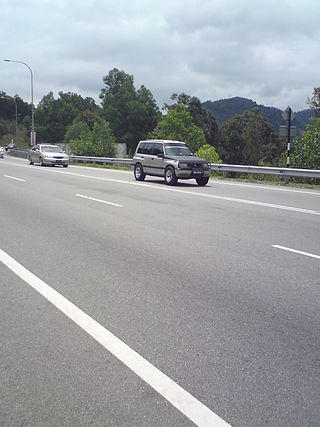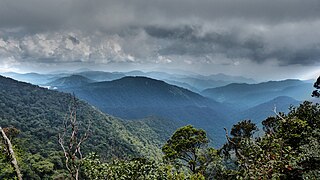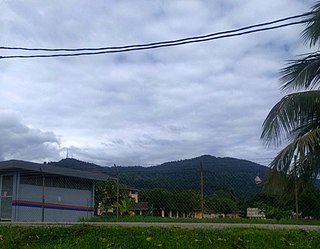
The Federated Malay States was a federation of four protected states in the Malay Peninsula — Selangor, Perak, Negeri Sembilan and Pahang — established in 1895 by the British government, and which lasted until 1946. In that year they formed the Malayan Union together with two of the former Straits Settlements,, and the Unfederated Malay States. Two years later, the union became the Federation of Malaya, which achieved independence in 1957, and finally Malaysia in 1963 with the inclusion of North Borneo, Sarawak and Singapore.

Negeri Sembilan, historically spelled as Negri Sembilan, is a state in Malaysia which lies on the western coast of Peninsular Malaysia. It borders Selangor on the north, Pahang in the east, and Malacca and Johor to the south.

The Jelebu District is the second largest district in Negeri Sembilan, Malaysia after Jempol, with a population over 40,000. Jelebu borders on the Seremban District to its west and Kuala Pilah District to its south, Jempol District to its southeast, Bentong and Bera Districts, Pahang to its east and Hulu Langat District, Selangor to the north. Jelebu is a suburban district with blossoming semi-agricultural industry. Jelebu is also a parliamentary constituency of the Dewan Rakyat in the Malaysian Parliament. Kuala Klawang is the principal town of the district.

The Pahang River mainly flows through the state of Pahang, Malaysia. Its drainage basin covers its Pahang as well as the neighbouring state of Negeri Sembilan.

Tampin is a town in Tampin District, Negeri Sembilan, Malaysia, which borders Pulau Sebang town in Alor Gajah District, Malacca. It is situated at the southern tip of the longest mountain range in Malaysia, the Titiwangsa Mountains.
Federal Route 55 or Jalan Kuala Kubu Bharu–Teranum–Raub is a 62-km federal road connecting the states of Selangor and Pahang in Malaysia. It is the first federal road ever constructed in Pahang. The road connects Kuala Kubu Bharu, Selangor to Teranum near Raub in Pahang where it meets Federal Route 218. It is the main access route to Fraser's Hill.

Jalan Seremban-Kuala Pilah or Federal Route 51 is the main federal road in Negeri Sembilan, Malaysia, connecting Seremban to Kuala Pilah. It is a relatively busy road in Negeri Sembilan.
Mount Nuang is located in Malaysia with the height of 1,493 metres (4,898 ft). Its peak borders Pahang and Selangor state and is close to the Pahang-Selangor-Negeri Sembilan border tripoint. The mountain itself is the third highest point in Selangor after Mts. Semangkok and Ulu Kali, and is part of the Titiwangsa Mountains.

Federal Route 9 or Karak–Tampin Highway is a federal road in Pahang and Negeri Sembilan, Malaysia. It connects Karak, Pahang in the north with Tampin, Negeri Sembilan in the south, running along the eastern edge of the Titiwangsa Mountains.

This article lists important figures and events in Malaysian public affairs during the year 1982, together with births and deaths of notable Malaysians.

The Perak River is the second longest river in Peninsular Malaysia after Pahang River in Pahang, Malaysia.
Konsortium Transnasional Berhad (KTB) (MYX: 4847) is one of the largest public bus operator in Malaysia. The company provides services of stage buses and express buses covering all major cities and towns in Peninsular Malaysia as well as routes to Singapore. KTB debut on Bursa Malaysia on 15 June 2007.

The Titiwangsa Forest Complex runs along the Titiwangsa Mountains and forms part of the Central Forest Spine of Peninsular Malaysia.

Kuala Pilah, or simply Pilah, is a town in Kuala Pilah District, Negeri Sembilan, Malaysia. It is 36 km from the state capital Seremban and 101 km from Kuala Lumpur.

Mining is one of the main industries in Malaysia. Malaysia produces aggregate, bauxite, clay, coal, copper, feldspar, gold, gravel, ilmenite, iron ore, kaolin, limestone, mica, monazite, sand, silica sand, struverite and tin.

Bentong District is a district located in western Pahang, Malaysia. Bentong covers an area of 1,831 km2 and includes the hill resorts of Genting Highlands and Bukit Tinggi. It is located 80 km northeast of Kuala Lumpur, just across the main range, Titiwangsa Mountains. Bentong Town is the seat of the district. The district of Bentong is also further divided into 3 mukims (sub-districts), they are Bentong, Sabai and Pelabgai. The original Main Street going into Bentong Town has been modified to a dual carriageway. It is bordered by Selangor on the west and Negeri Sembilan on the south.
Malaysian Cantonese is a local variety of Cantonese spoken in Malaysia. It is the lingua franca among Chinese throughout much of the central portion of Peninsular Malaysia, being spoken in the capital Kuala Lumpur, Perak, Pahang, Selangor, Putrajaya and Negeri Sembilan, it is also widely understood to varying degrees by many Chinese people throughout the country, regardless of their ancestral language.

Mount Tampin is a mountain in Tampin District, Negeri Sembilan, Malaysia, close to the border with Malacca.
Mount Besar Hantu is a mountain in Kenaboi, Jelebu District, Negeri Sembilan, Malaysia, located near the border with Pahang. It is the tallest peak in Negeri Sembilan as well in southern Peninsular Malaysia, at the height of 1,462 m (4,797 ft).

Mount Telapak Buruk is a mountain situated on the boundary between Jelebu and Seremban Districts in the Malaysian state of Negeri Sembilan. At an altitude of 1,193 metres above sea level, it is the third tallest mountain in Negeri Sembilan and the tallest mountain fully within the state.













































